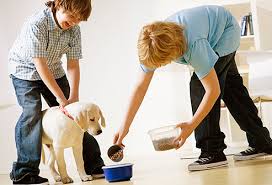Training a puppy is hard work, especially if you have no idea how to start the process. It is not quite as simple as just jumping right into the middle of a training session – each puppy is unique, and its relationship to its owners has to develop in a natural, highly specific way.
But how do you get started with puppy training when you have no past experience or no idea where to begin?

What does puppy training cover?
Puppy training, as a whole, is all about building up a relationship between you and your new puppy. With this relationship, you can shape how they behave and allow them to develop in specific ways, which can be important for their further development.
Training a puppy also has a major focus on positive reinforcement. Most dogs respond poorly to being punished, but praising them or giving them treats can help reinforce good behaviors and give them a certain way of acting around other people.
When you first get a puppy, training them in the basics – potty training, keeping them away from certain bits of furniture, stopping them from barking, or being greedy – can all be very important. However, once you get past that, it is easy to feel a bit lost. Well Known Ethical Goldendoodle Breeders will have many good ideas and tips for that specific type of dog breed based on genetics and that can come in very handy with training.
Signals
Potty training is one of the most common reasons to start training a puppy. It allows you to tell them where they can go and also helps you identify any signs or signals that they might give if they are desperate. Knowing this is incredibly important in the long run, especially once they get older.
A large part of basic training is making sure that you understand them. A puppy will act and react based on what you do with them, so knowing what emotions they are showing and how they are feeling can make it a lot easier to handle them.
For example, when your puppy needs to poop, what does it do? Do they go and paw at the front door, or do they stand around awkwardly? You can train them not to go on the floor, but you still need to identify the times that they have to be taken outside for a while. After your puppy is potty trained, then you can take the easy route and hire a poop pickup service to clean up your yard after the long winter.”
Good training is not just about the puppy, but about your understanding of why they act in a certain way and what can control, change, or reinforce it.
What should I train them for?
A common misconception is that you have to train a puppy for something or that there are only certain ways of training a puppy. However, most puppy training is purely based on getting them to react to certain things in specific ways, ingraining certain behaviors into them.
For example, if a puppy gets a treat or a stroke for doing something, they might do it more often. The goal of training them is to make this more likely without the treat being involved – for example, giving them a defined potty spot or keeping them away from certain seats.
Training your puppy means identifying the weak spots and potential risks that they might run into. If they get greedy and bark for food, stopping that behavior is part of their training. If they are nervous, then easing them into social training might be the main focus instead.
Choosing how to train
Training is not a straightforward binary choice – there are a lot of different ways to train a puppy, ranging from doing it yourself (not recommended for new puppy owners) to getting online help and advice from a professional.
Each puppy is different, and the relationship that you have with them will be unique, so you always have to tailor your training to your needs. Even with that in mind, having some idea of a starting point can at least point you in the vague direction of more useful training options.
While it can be tempting to send your puppy off for third-party puppy training, this is not a good idea. Without having you present, your puppy will not develop that connection with you, and you will not be able to train yourself on what your puppy needs or how it responds to different situations.
Online Training
Online puppy training can be a very powerful tool for dealing with puppies that you can’t handle alone. Not having another person in the room means that the puppy is entirely focused on you, but you still get that professional advice and the expertise of a full-blown trainer.
This might be useful for dispelling puppy training myths, getting around the limitations of scheduled classes, or dealing with a puppy who is too nervous to take to any kind of major in-person training class. It also allows you to bond with them in private, without interruptions.
Online puppy training is a very convenient choice and one that many people have been turning to. It can suit almost every situation and is far more reliable for people who have busy schedules or need to spend a lot of time at home with their new pup.
Professional Training Help
Whether offline or online, training should involve a lot of major help from professional sources, whether that is an actual trainer or advice from a respected training information source. There are a lot of myths and untrue ‘facts’ about puppy training that can actually be harmful to your dog.
While some people like to try and figure it all out by themselves, this also runs the risk of them doing permanent damage to their puppy’s behavior. The more you experiment, the more likely you are to accidentally mess up, which could lead to problems if your puppy gets the wrong message from you.
Relying on professional training advice and tactics can make it much simpler for both you and your puppy. If you have any specific requirements or things to add, then you can use them to build from the basic training materials that you are using.
Always get the basics done first before trying to teach your puppy anything complex or specific. You can tell them not to bark at the doorbell, but that might not mean much if they are still barking for food or getting aggressive when somebody comes near their bed.



